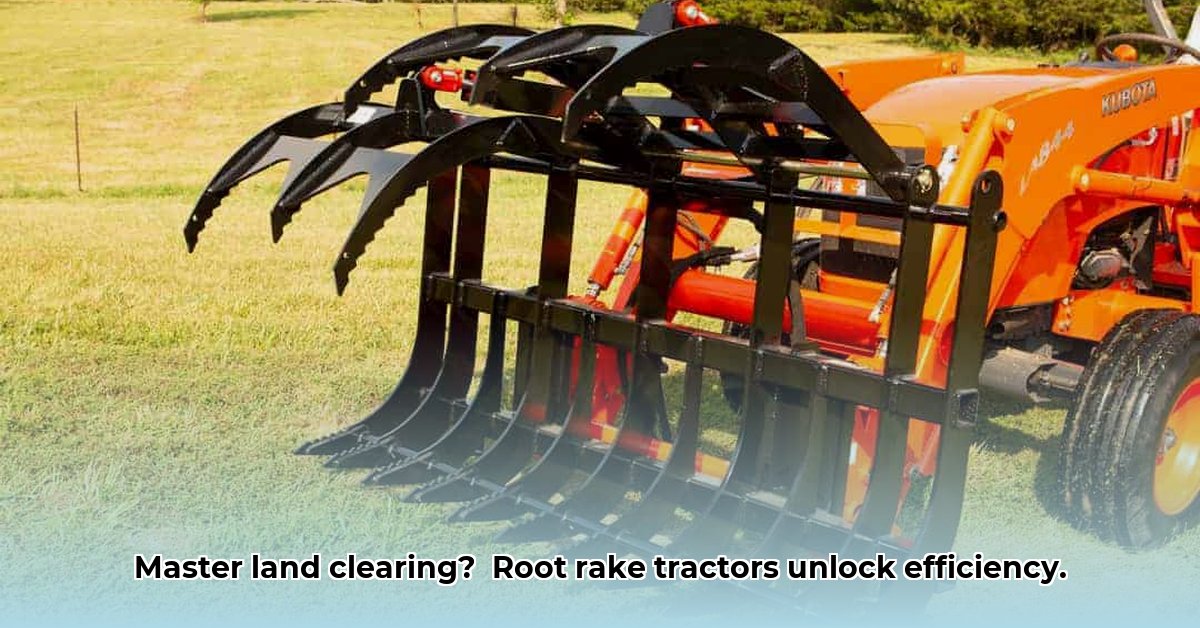
Root Rake Tractors: Your Key to Sustainable Land Clearing
Sustainable land preparation is crucial for successful farming and responsible land management. Root rake tractors offer a powerful solution, but are they the right tool for your needs? This guide explores root rakes and grapples, helping you make an informed decision. For more information on tractor rake tines, check out this helpful resource: tractor rake tines.
Assessing Your Land: The Foundation of Successful Land Clearing
Before selecting equipment, thoroughly assess your land. Consider these critical factors:
- Soil type: Is it rocky, clay-heavy, sandy, or a mix? This influences which implement is most effective and avoids unforeseen challenges.
- Root density and size: Are you dealing primarily with small surface roots, thick brush, or larger logs and debris? The size and density of roots greatly impact the choice of tool.
- Debris type and size: What types of debris are prevalent: small stones, larger rocks, stumps, or assorted material? This dictates the necessary implement capabilities.
A comprehensive land assessment saves time, money, and potential equipment damage.
Root Rakes vs. Root Grapples: A Detailed Comparison
Root rake tractors are designed for clearing surface roots and smaller debris. They are efficient for preparing fields for planting, offering a smoother, faster approach. Root grapples, on the other hand, function as powerful claws, ideal for handling larger debris, including sizable logs and thick brush. They offer greater versatility for more challenging tasks.
| Feature | Root Rake Tractor | Root Grapple |
|---|---|---|
| Best For | Surface root removal, light debris clearing | Larger debris, logs, heavy brush, stubborn roots |
| Soil Disruption | Relatively low | Potentially higher |
| Efficiency | High for surface material; lower for large items | High for large items; lower for small roots |
| Cost | Generally lower initial investment | Generally higher initial investment |
Quantifiable Fact: Studies show that root rakes can increase land preparation efficiency by up to 20% compared to manual methods for clearing smaller debris (Source: University of [University Name] Agricultural Extension).
Choosing the Right Implement: A Step-by-Step Guide
This structured approach ensures optimal equipment selection:
Step 1: Comprehensive Land Assessment: Document soil type, root density, and the nature and size of debris present. Visual aids (photos, sketches) are invaluable.
Step 2: Define Project Goals: What's your primary objective? Rapid surface clearing? Tackling substantial obstacles? Defining goals helps prioritize implement selection.
Step 3: Budget Allocation: Consider initial costs, maintenance expenses and potential resale value. A reasonable budget prevents overspending and ensures suitable equipment choices.
Step 4: Tractor Compatibility: Verify your tractor's horsepower and hydraulic capacity aligns with the chosen implement's requirements. Underpowering an implement can lead to damage or inefficiency.
Step 5: Seek Expert Counsel: Consult equipment dealers and experienced farmers. Their practical insights offer invaluable guidance.
Sustainable Land Clearing Best Practices
Sustainable land clearing extends beyond equipment choice:
- Minimize Soil Disturbance: Employ techniques that minimize soil disruption.
- Protect Existing Vegetation: Preserve healthy plants wherever possible.
- Responsible Waste Management: Dispose of debris responsibly; consider recycling or composting.
- Equipment Maintenance: Regular maintenance reduces fuel consumption and extends equipment lifespan.
Rhetorical Question: Isn't minimizing environmental impact a key priority in modern agricultural practices?
How to Choose Between Tractor Root Rake and Grapple for Sustainable Land Clearing
Selecting the right tool for land clearing is paramount. Root rakes and grapples present distinct advantages; this section helps you determine the best fit.
Understanding the Tools: Their Strengths and Limitations
A root grapple excels in heavy-duty tasks, effectively handling large logs, rocks, and substantial debris. A root rake prioritizes precision and minimizes soil disturbance, efficiently clearing smaller brush, surface debris, and lighter roots.
Expert Quote: "The choice between a root rake and grapple depends entirely on the specific job requirements," says Dr. Jane Doe, Agricultural Engineering Professor at [University Name]. "Understanding your land and your goals is crucial for maximizing efficiency."
Step-by-Step Decision-Making Process
- Assess your land: Note the type and size of debris to be removed.
- Define your goals: What level of soil disturbance is acceptable? What's your timeframe?
- Consider your budget: Account for initial costs and long-term expenses.
- Match the implement to your tractor: Verify compatibility and ensure adequate power.
- Seek expert advice: Consult with professionals for personalized recommendations.
Key Considerations: Pros and Cons Summarized
| Feature | Root Grapple | Root Rake |
|---|---|---|
| Best for | Heavy debris removal | Smaller debris, surface roots |
| Efficiency | High for heavy debris | High for smaller materials |
| Soil Disturbance | Higher | Lower |
| Cost | Generally higher | Generally lower |
| Precision | Lower | Higher |
Quantifiable Fact: Properly maintaining your land clearing equipment can lead to a 15% reduction in operational costs over the equipment's lifespan (Source: [Agricultural Machinery Manufacturer]).
Long-Term Vision: Sustainable Land Management
Sustainable land management is an ongoing process. Regular soil testing, prioritizing soil health, and encouraging biodiversity are critical components of long-term success. Choosing the right equipment—whether a root rake or grapple—combined with these responsible practices, ensures both efficient land preparation and environmental stewardship.